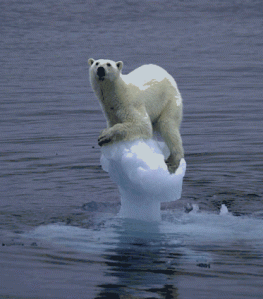AP reported today in a story that sea ice is at its second lowest levels in thirty years. This is concerning for the daily discourse on the health of the environment, but presumably not a siren call that all is lost and we are at a tipping point?
The broader issue of an unhealthy environment and melting ice cap quickly gives way to the atomic level as we contemplate the fate of specific animals (vs the theoretical – the planet is warming). “Federal observers flying for a whale survey on Aug. 16 spotted nine polar bears swimming in open ocean in the Chukchi. The bears were 15 to 65 miles off the Alaska shore. Some were swimming north, apparently trying to reach the polar ice edge, which on that day was 400 miles away.”
As I have opined in other blog postins that the plight of the polar bear is going to be “the tipping point” for this discussion on climate change. In a Reuters story today, “the U.S. Geological Survey said last September that two thirds of the world’s polar bears could be gone by mid-century if predictions of melting sea ice in the Arctic hold true.”
Since the US declared in “May it was listing polar bears as a threatened species”, their plight is inextricably linked to the threat of rising seas, melting ice and greenhouse gas. Their photos pull on the heart strings of the public in the lower 48 and will serve as a photogenic reminder that the planet is in peril, to use CNN’s tag line.
This discussion becomes all the more interesting with Sarah Palin’s nomination to the VP spot. Her approach to drilling and ANWR,
her acting as the conservative administration’s mouthpiece for environmental concerns will be a foci for the next two month’s presidential discussion (ANWR.org).
Prior to this morning’s annoucement, the environment was number 9 or 10 on the list of “hot buttons” for the candidates. I think it will quickly hit the radar and become a “top 5” issue discussed purely based on “where she is from” (ie Alaska). Fair or unfair, it will help elevate the discussion to the platform of the presidency. If her nomination acts as a catalyst to discuss the environment as a pressing concern, equal to that of terrorism, the economy, social security and international affairs, then by all means! Lets chat!







